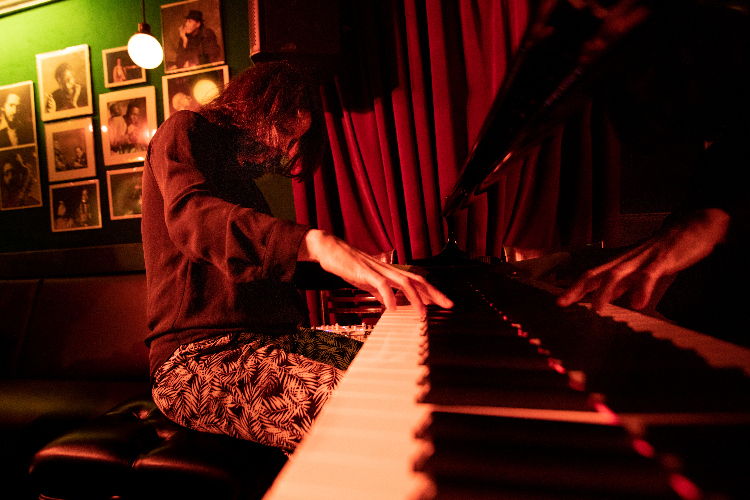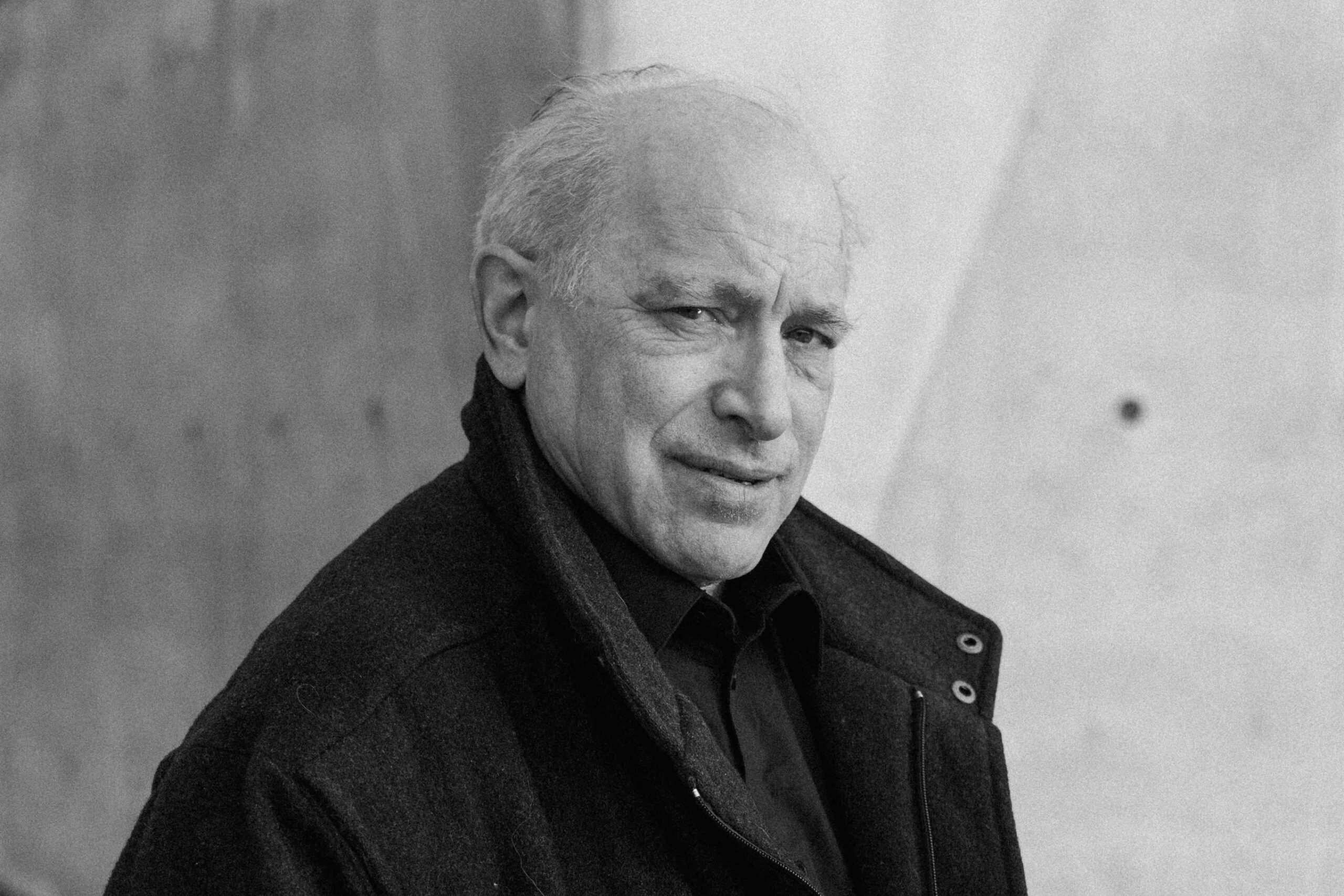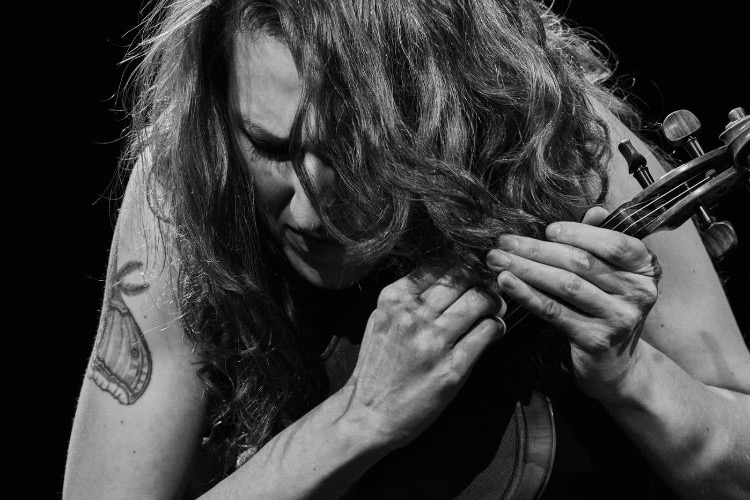Five Music Boxes: A Conversation with Kris Davis on ‘Diatom Ribbons Live at the Village Vanguard’
|
Getting your Trinity Audio player ready...
|
In Brian Kiwanuka’s excellent review of Kris Davis’ latest Diatom Ribbons album, he outlines how the music presented fits within the context of the pianist’s output to date. It’s a compelling analysis, but an equally worthy one is where to place the work within the history of the venue where recorded. Where does Diatom Ribbons Live at the Village Vanguard (Pyroclastic, 2023) lie within the nearly nine-decade story of the legendary club?
One trap many fall into in examining history is reviewing facts and assuming the existence of foregone conclusions. In retrospect, one can easily see the sonic trajectory from Bill Evans in the 1960s [Sunday at the Village Vanguard (Riverside, 1961)] to Fred Hersch only a few years ago [Sunday Night at the Vanguard (Palmetto, 2016)]. But for those living through history, the future is anything but certain. What sets the Vanguard apart from most venues is the apparent freedom artists seemingly feel when performing there to push beyond the status quo. It is these artists pushing themselves musically that created the breadcrumbs for future generations to follow.
Diatom Ribbons Live at the Village Vanguard does not ignore the lineage before it. Davis has long established her avant-garde bona fides and, to some extent, the ghosts of John Coltrane, Eric Dolphy, Alice Coltrane, and Pharaoh Sanders [Coltrane “Live” at the Village Vanguard (Impulse!, 1962) and Live At The Village Vanguard Again! (Impulse!, 1966)] are seemingly summoned in the pianist’s latest output. As to Dolphy specifically, his “Hat and Beard” is referenced in “Nine Hats.” The record also pays homage to Geri Allen – one of the shockingly few female instrumentalist leaders to precede Davis in recording at the Vanguard – by playing her composition, “The Dancer”.
But, like her predecessors, Davis succeeds by finding a sound all her own. At times, the quintet sounds deceptively traditional. Only upon closer listening of both takes of Wayne Shorter’s “Dolores” or “The Dancer” does one realize how electronics cut and carve the edges of notes to make them fit into different patterns. Val Jeanty’s contributions imbue the work with elements of hip-hop or electronica without going too deep into either. The samples and effects also play a central role in capturing the bandleader’s love of contemporary classical music. References to Messaien and Stockhausen sit alongside those of Paul Bley and Sun Ra, underscoring their shared artistic legitimacy. Reverence for classical composers is hardly new among “jazz” composers. For one, Coltrane’s love of Stravinsky is well-documented. But the group’s approach – by incorporating spoken word clips to further the musical narrative – is indeed novel.
The Bley clip on “Bird Call Blues” speaks of an artist who “was always playing ahead of what was coming.” While Bley was speaking specifically of Charlie Parker, one could apply the descriptor to many artists throughout the history of improvised music, including those who made the Vanguard such a special place by pushing themselves to their artistic limits. These artists refused to confine themselves to some stylistic limitations, in furtherance of a more compelling musical outcome. After experiencing the jazz-contemporary classical-electronic-hip-hop hybrid of Diatom Ribbons Live at the Village Vanguard, it is difficult not to place Kris Davis among them.
We caught up with Davis at the 2023 Newport Jazz Festival right after taking part in an incredible set by the Dave Holland New Quartet, along with Jaleel Shaw and Nasheet Waits.
PostGenre: That was an incredible performance with Dave Holland’s Quartet. Does the group plan on recording an album?
Kris Davis: Yeah, I think so. Dave has so many bands, and he’s just trying to figure out timing. I think he wants to record the quartet, but it probably wouldn’t be until next year.
PG: But before that, you will release Diatom Ribbons Live at the Village Vanguard. One notable thing about the recording is its use of electronics. Far too often electronic effects bring a certain abrasiveness to music, but Val Jeanty’s contributions are often very subtle. How much guidance did you give her in terms of the sound you were seeking?
KD: Many of her sounds are hers, but I also gave her certain things. I gave her some recordings I made on the piano and prepared piano. I also gave her the recording of a trumpet line played by one of my friends. Often, I gave her these recordings to use however she wanted. Some other things, however, are much more specific in how I wanted them used. For example, on “[Bird Suite, Part 3] Parasitic Hunter”, she uses elements of [Karlheinz] Stockhausen’s voice to direct us to certain types of musical ideas. I would say that maybe 60% of what she uses is stuff I’ve given to her, and 40% is from her bank of sounds.
PG: Stockhausen’s recording is far from the only spoken word clip used on the album. It also features recordings of interviews with Paul Bley, Sun Ra, and Oliver Messiaen. What was your process for finding and selecting these clips? Did you simply go through old interviews and find things you liked?
KD: Basically. It really started on the first Diatom Ribbons (Pyroclastic, 2019) record. I took Cecil Taylor’s voice and used it on the album’s title piece to pay tribute to him. I found just some clips of his that were meaningful to me and began working with them. This live recording was an extension of that idea; I took pieces of things I found from other artists who are important to me.
“Bird Call Blues” uses a sample of Messiaen’s voice, and he used to draw inspiration from bird calls. And then, in the same song, Paul Bley comes in talking about Charlie Parker. We were supposed to do a Charlie Parker Centennial Tour, which didn’t happen because of COVID. It was also meaningful that the piece was based on Messiaen’s “Petites Esquisses D’Oiseaux.” There are all these different little reference points in the song. I like that there are elements of humor in the live recording. Humor is so hard to convey in music. You often either have in your face slapstick or something tongue-in-cheek. I like that this piece brings the audience inside the joke, in a way, through its playfulness.
PG: You also sampled Messiaen on the original Diatom Ribbons. How do you feel he has influenced you as a composer?
KD: Messiaen’s influence is certainly reflected in the movements of the Bird Suite. “Kingfisher” and “Parasitic Hunter” [movements one and three] were both influenced by Messiaen’s mode of limited transposition. But “Bird Call Blues” [movement two] was based on an actual Messiaen bird call piece blended with Charlie Parker.
Messiaen has influenced me a lot. I like how he was influenced by these bird calls and tried to figure out how to reflect them musically. Of course, his instrument couldn’t make those quarter tones that birds make. [Thelonious] Monk tried to make quarter tones by playing a half step and then releasing one of the notes to create the effect of bending and messing with it. Messiaen tried to emulate those sounds by playing dyads that are things like minor ninth or seventh. Then he moved them around so they were not always the same. They are not in parallel motion, and it creates that effect, as best as we can on the piano, of those kinds of microtones.
PG: So, did Messiaen’s work open up your conception of how to play the piano beyond traditional methods?
KD: Yeah. There was a [period] when I lived in New York where I didn’t listen to the piano at all. I’d go to concerts to see what could be done without a piano and try to think of ways to transport those ideas to the piano. Something about that process of not listening to piano players opened things up for me and made me start thinking more about outside sounds. I started wondering things like if five music boxes were playing simultaneously, what would it sound like, and how can I try to incorporate that into the piano? Those thoughts greatly expanded how I approach the piano.
PG: You mentioned the third movement of Bird Suite a little earlier and how the pandemic disrupted your Parker Centennial tour. Interestingly, on the album, you have part one separated from parts two and three by the song “Endless Columns.” Did you split apart the suite’s movements as a commentary on how COVID ruined your plans?
KD: No. The movements were split up solely because that is how the set played out live.
PG: In terms of things playing out differently live, by adding Julian Lage, you also have a slightly different group as part of this live recording than on the original Diatom Ribbons. The original album featured Nels Cline and Marc Ribot as guests on different tracks, but with the live group, you have Julian fully integrated into the band. How do you feel Julian’s presence changed the group?
KD: With the live recording it was a significantly different process than the studio album. With the first album, we just came in, learned a song in 20 minutes, and then recorded it. With the live one, we played the same set in the same order with the same group every day for a week. There was more time to figure out how a piece works and how we wanted to approach it. Many of the differences between the first album and this one are purely due to us approaching things differently.
As far as Julian, he is such a lyrical player. He’s also always looking to branch out and expand what he does musically. I think this music does that for him in a way. He’s also a very melodic player. – he sings through the guitar – which enhances the pieces.
PG: Another difference between the new recording and the first Diatom Ribbons is that it was recorded live. The Vanguard is a legendary venue; do you feel something specific about the Vanguard that is audible in the live album?
KD: Well, the Vanguard has a small stage. With five people, you’re all jammed in there. All of the mics are bleeding into one another, which is problematic for recording. There’s no way completely around that problem But that’s the thing: a live recording is just a documentation of where a band is at that date. Working with an excellent engineer, we mixed the album for three months, and it turned out the best it could. I’m very happy with how it turned out, but it’s still primarily a documentary of how the group sounded at that point in time, just due to its nature as a live recording.
PG: Another interesting aspect of the recording is that you are only the fourth female instrumentalist bandleader in the venue’s almost ninety-year history to record there. Did you feel a lot of pressure because of how limited the history is in those regards?
KD: Not really. When you go into the Vanguard and look at the walls, there are very few pictures of female musicians on the walls. But things are changing – the Vanguard has been doing a good job with programming, and things are slowly shifting.
I think that increased representation of female musicians is important. I teach at the Institute of Jazz and Gender Justice at Berklee [College of Music], and I think it’s important for my students to see me do this album and that I have made it to a certain point in my career. I do that as someone who loves experimental music and is also a mom. All those things mean something to my students and the young people coming up.
Diatom Ribbons Live at the Village Vanguard is now available on Davis’ label, Pyroclastic Records. It can be purchased on Bandcamp.
Photo credit: Caroline Mardok




2 thoughts on “Five Music Boxes: A Conversation with Kris Davis on ‘Diatom Ribbons Live at the Village Vanguard’”